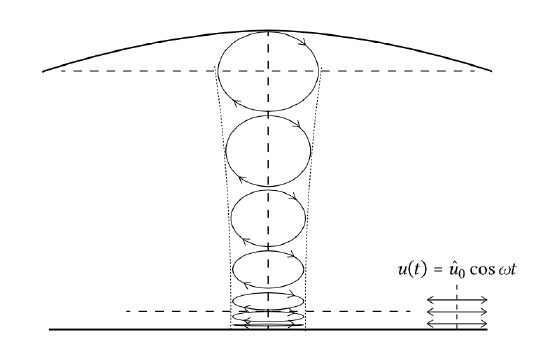5.4.1: Wave orbital velocities
- Page ID
- 16323

So far we have focused on the wave surface elevation. Underneath the wave surface, there is a fluid motion associated with the motion of the water surface; the fluid particles describe an orbital path. To first order (within the limitations of Airy small amplitude wave theory), the orbits are closed5 circles in deep water and closed ellipsoids in water of finite depth with the ellipsoids becoming flatter near the bottom. At the bottom vertical velocities are zero per definition. The further from the surface, the smaller the orbital diameter becomes. In deep water the orbital diameter has been reduced to only 4% of the value at the surface at a depth of half a wavelength. In the case of shallow water, the water particles under a propagating wave of finite amplitude describe an elliptical orbit. From the surface down to the bottom, the vertical displacement of the water particles reduces to zero, while the horizontal displacement remains almost constant (Fig. 5.20).
Now consider waves of infinitesimal amplitudes. According to linear theory, the horizontal orbital velocity varies harmonically with an amplitude \(\hat{u}\) equal to:
\[\hat{u} (z) = \omega a \dfrac{\cosh k(h + z)}{\sinh kh}\]
where:
| \(\omega\) | angular frequency \((2\pi /T)\) | \(Hz\) |
| \(a\) | wave amplitude | \(m\) |
| \(k\) | wavenumber \((2\pi /L)\) | \(1/m\) |
| \(L\) | wavelength | \(m\) |

The \(z\)-axis is defined positive upward with \(z = 0\) at the surface and \(z = -h\) at the bottom. The velocity \(u\) is in the wave propagation direction. Using the \(\cosh kh\) and \(\sinh kh\) approximations for shallow and deep water (App. A), the horizontal velocity profiles can be drawn schematically as in Fig. 5.21.
In shallow water (\(kh \ll 1\); in practice \(kh < \pi /10\) or \(h/L > 1/20\)), the depth-uniform velocity amplitude is given by (cf. Eq. 3.8.1.8):
\[\hat{u} = \dfrac{\omega a}{kh} = c \dfrac{a}{h} = \sqrt{gh} \dfrac{H}{2h}\]
The particle excursions (i.e. the horizontal and vertical displacements of the particles) are the time integrals of the oscillatory horizontal and vertical flow velocities respectively. This means that the amplitude of the horizontal particle excursion is given by:
\[\hat{\xi} = \dfrac{\hat{u}}{\omega}\]
Note that Sect. 5.3 described how in shoaling waves the surface elevation becomes gradually more skewed and asymmetric. Of course the wave orbital velocities near the bed will also become skewed and asymmetric. Although the linear approximation will not describe the changing wave form, the orbital velocity magnitude can be estimated reasonably well using linear wave theory.
5. At second order particle paths are no longer closed orbits and there is a drift or mass transport in the direction of wave propagation (Sect. 5.5.1).


